This summer my wife and I spent just over two glorious weeks in Spain. In addition to experiencing the rich Spanish culture and history, as well as dedicated time with my wife, I found myself reminded at times of important life lessons. This short blog series will focus on the five lessons that jumped out to me the most.
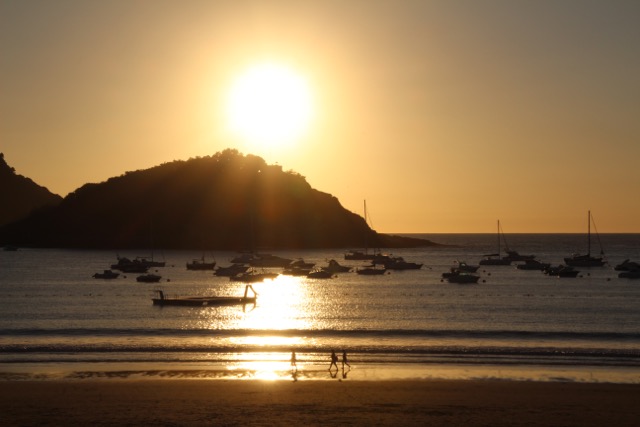 After leaving Madrid, my wife and I headed up to the northern part of Spain to Basque country and visited San Sebastián/Donostia. The city goes by both names, both the Spanish version and the Basque version. It’s the most beautiful place I’ve ever visited and I’m not joking when I say that I will A) definitely return at some point in my life and B) hope to find a way to spend a great deal of my retirement there.
After leaving Madrid, my wife and I headed up to the northern part of Spain to Basque country and visited San Sebastián/Donostia. The city goes by both names, both the Spanish version and the Basque version. It’s the most beautiful place I’ve ever visited and I’m not joking when I say that I will A) definitely return at some point in my life and B) hope to find a way to spend a great deal of my retirement there.
The city is a very popular tourist destination, known for it’s incredible beach and incredible food. A few of the top 50 restaurants in the world are located here (one was on a vacation break while we were there and we opted to skip the other in favor of some other excursions) and the city has one of the highest number of Michelin stars per capita in the entire world. 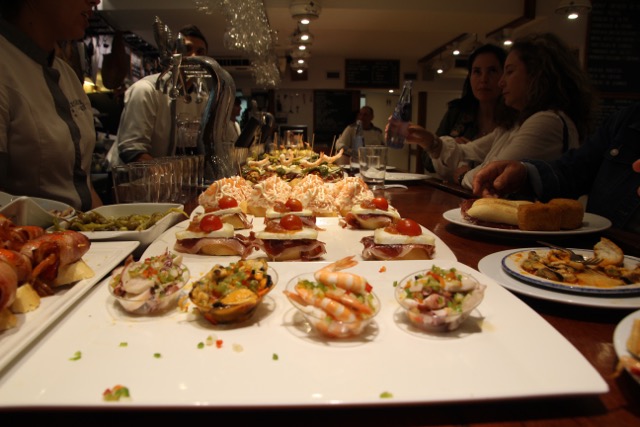 Each night we enjoyed walking through the streets and popping into many small establishments to enjoy Pinxtos–the local version of tapas (absolutely delicious).
Each night we enjoyed walking through the streets and popping into many small establishments to enjoy Pinxtos–the local version of tapas (absolutely delicious).
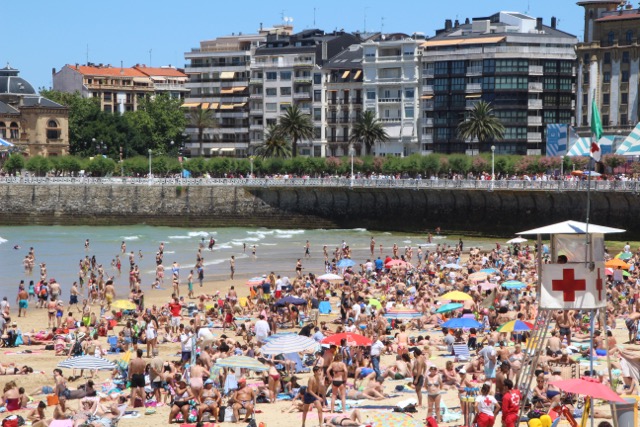 During the day, we lounged on the world famous beach, quite crowded during the day, and serene and calm each night as the tide came in virtually eliminating the sand. If you’ve never been to Europe, the beach culture is quite different than the US. People basically come down to the beach with a towel, a bottle of water, some sunscreen, and a book. Older people will pack a chair or two and some will bring an umbrella, but otherwise that is it. No coolers full of food (there are small restaurants that sell ice cream, bocadillos, and water), no major music, and not too many frisbees or paddle boards–just mainly people enjoying the water or reading on the beach. Elderly couples hang out next to teens who are next to families with kids who are next to young newlyweds.
During the day, we lounged on the world famous beach, quite crowded during the day, and serene and calm each night as the tide came in virtually eliminating the sand. If you’ve never been to Europe, the beach culture is quite different than the US. People basically come down to the beach with a towel, a bottle of water, some sunscreen, and a book. Older people will pack a chair or two and some will bring an umbrella, but otherwise that is it. No coolers full of food (there are small restaurants that sell ice cream, bocadillos, and water), no major music, and not too many frisbees or paddle boards–just mainly people enjoying the water or reading on the beach. Elderly couples hang out next to teens who are next to families with kids who are next to young newlyweds.
We loved it.
Unfortunately, San Sebastián is also known for the rain and even in July it’s difficult to get too many days in a row there without some rain–our trip was no different.
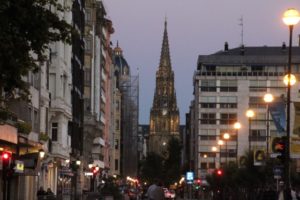 We still enjoyed the city. We enjoyed a nice long lunch (as I described in the first blog of the city), and while quickly inquiring at an information booth about transit to the next stop on our trip, we learned about a free walking tour we could take about the history of San Sebastián/Donostia. With no beach plans, we decided to sign up.
We still enjoyed the city. We enjoyed a nice long lunch (as I described in the first blog of the city), and while quickly inquiring at an information booth about transit to the next stop on our trip, we learned about a free walking tour we could take about the history of San Sebastián/Donostia. With no beach plans, we decided to sign up.
It was such a lovely treat.
My wife and I ended up being the only two people on the tour with our young guide showing us the way. We were the first tour he had ever conducted in English, my wife (using her incredible Spanish skills), helping him with a phrase or two. Overall, it was a great experience. Halfway through the tour, our guide stopped on a bridge to say hello to an older gentlemen and visit–turns out, it was his dad–that’s how small and friendly San Sebastián/Donostia is.
I won’t go too in depth about the tour (it’s a nice thing you should do on your own visit), but I do want to highlight one thing:
the flowers.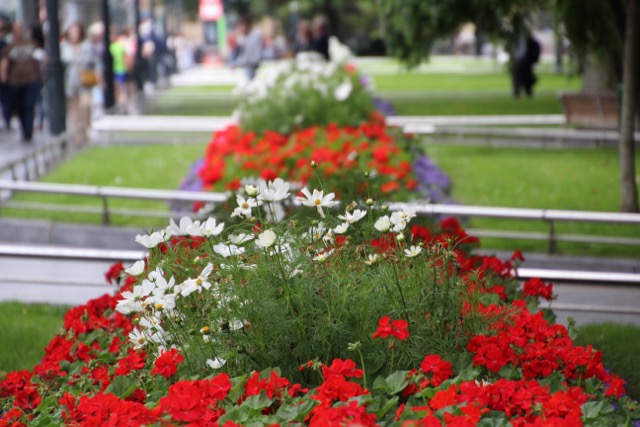
We had noticed them as he walked the streets the previous days and when we waited for the start of our tour. Long rows of flowers planted in a very organized manner.
According to our guide, the flowers mark the spots of the walls. Years ago San Sebastián/Donostia was another protected place, designed for battle. After once such battle, the people decided that it was time to stop building walls, and instead to welcome people in. They tore down the walls and planted flowers. They built a spa almost 100 years ago that still exists today (my wife enjoyed a massage there one afternoon). They decided they wanted to make Parisians feel more at home, so they built some streets to resemble those in Paris.
They built theaters, parks, restaurants, and casinos. They decided they wanted to become a place where people could relax and vacation.
In the process they etched their place as a cultural destination in Europe. One where a person could relax and also enjoy art and food.
I’ve never been anywhere that comes close to the feeling of this city and its people.
And I wonder…
Can we tear down the walls we’ve built and plant more flowers?
There is no doubt that the decision had to be somewhat controversial at the time. What would have happened if there was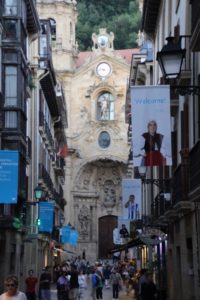 another war (and there were wars after this)? What would happen if someone took over? What would happen if someone destroyed all that they had built?
another war (and there were wars after this)? What would happen if someone took over? What would happen if someone destroyed all that they had built?
It was a risk they were willing to take and the city and all who visit are better because of it.
San Sebastián/Donostia is a place of beauty and culture. It is a place where my wife and I found ourselves reconnecting to all that is good in the world.
Can we create more good as well? Instead of division, can we create more beauty?
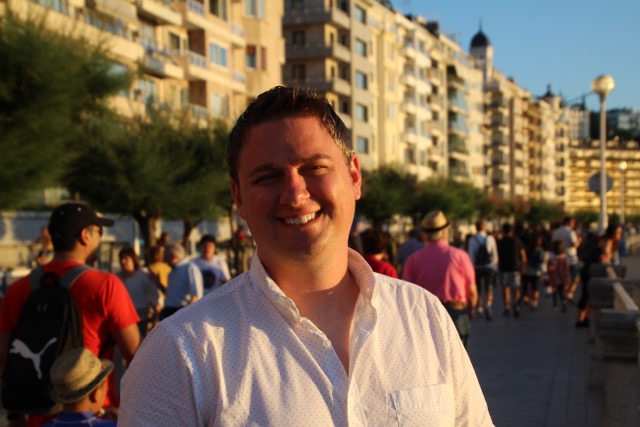
Patrick Maurer, CSP (Certified Speaking Professional), is a Keynote Speaker for conventions, conferences, and assemblies, and Facilitator of incredible retreats and teambuilding session. His perfected approach of fusing compelling topics with real-life account, insights, humor, and pop culture savviness have entertained and enriched audiences throughout North America for over a decade. pmaurer.com

